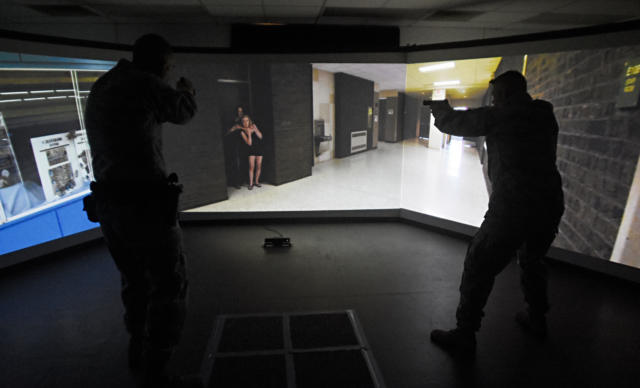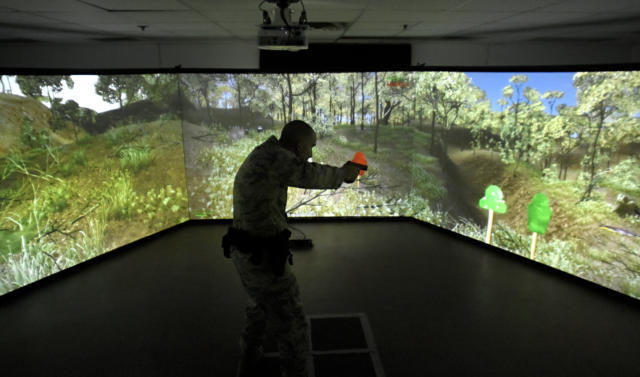Ready for anything at KAFB
By Charles D. Brunt / Albuquerque Journal Staff Writer, Monday, August 8th, 2016

Using a training system called the Multiple Interactive Learning Objectives simulator, or MILO, Staff Sgt. Brandon Gomez, left, and Tech. Sgt. Justin Jacobsen of the 377th Security Support Squadron at Kirtland Air Force Base participate in an exercise involving a gunman in a school. (Dean Hanson/Albuquerque Journal)
Copyright © 2016 Albuquerque Journal
Tech Sgt. Justin Jacobsen and Staff Sgt. Brandon Gomez, both of whom are with the 377th Security Support Squadron at Kirtland Air Force Base, stopped a 72-year-old man in a pickup truck for speeding on a dirt road. The man told the airmen that his driver’s license was in a duffel bag in the bed of his truck.
But when he reached into the back of the truck, he pulled out a pistol, whirled around and aimed it at the cops – who opened fire with their 9mm Baretta pistols, sending the old boy to his maker.
Fortunately for the elderly driver, the encounter last week unfolded during a training session on the base’s new high-tech MILO simulator.
MILO, or the Multiple Interactive Learning Objectives simulator, is proving to be an invaluable training tool for the more than 600 security personnel who keep the sprawling 51,558-acre base safe and secure, said Jacobsen and Gomez, instructors in charge of training law enforcement and security personnel at Kirtland.
Imagine an interactive, room-sized, IMAX-like theater where police trainees walk through stunningly realistic scenarios – ranging from a seemingly routine traffic stop to confronting multiple shooters inside a school – and you’ll have some idea of what MILO is all about.
Weapons available for training exercises in Kirtland Air Force Base’s Multiple Interactive Learning Objectives simulator include a handgun, a Taser and pepper spray. (Dean Hanson/Albuquerque Journal)
But as the TV huckster says, “That’s not all!”
The system is interactive and seamlessly responds to, and records, the trainees’ actions. Using laser inserts that fit into the trainees’ actual weapons – ranging from pepper spray and a Taser to handguns and assault rifles – the system times their reactions, shows where their bullets hit and, in a worst-case scenario, tells them the bad guy won the encounter.
Kirtland is the only active-duty Air Force base that has this particular system, known as the MILO Range Theater 300. The $170,000 system was installed in January, and more than 500 of the base’s roughly 600 security personnel have already trained on it. Some of them perform police duties, and others protect unclassified and classified “base assets.”
Jacobsen, who’s in charge of training security forces, said the squadron provides mandatory annual training as well as use-of-force training for all of the 377th Security Forces, an Army Reserve unit and a maintenance squadron.

Staff Sgt. Brandon Gomez of the 377th Security Support Squadron at Kirtland Air Force Base participates in a training exercise on the Multiple Interactive Learning Objectives simulator. (Dean Hanson/Albuquerque Journal)
The training includes classroom instruction, time on the simulator and testing to determine a trainee’s proficiency. Each trainee typically goes through two to four scenarios on the simulator during training.
“There are more than 800 scenarios, and within those scenarios are different options the instructors can control, so actually you get 1,000-plus different scenarios,” Jacobsen said.
Last week, Jacobsen and Staff Sgt. Brandon Gomez, who handles law enforcement training, demonstrated MILO’s capabilities by going through a series of scenarios on the simulator: the aforementioned traffic stop with the 72-year-old man; a domestic violence call; a group of active shooters inside a school; a pickup truck that runs through a base gate; and a despondent man armed with a handgun.
When trainees go into the simulator, they have only minimal information about what they might encounter – much like they’d get from a radio dispatcher.
“We’ll tell them what they’re responding to, but for the most part, it’s up to the trainee to react to the situation,” Jacobsen said.
The goals are to ensure that each trainee uses the minimum amount of force necessary to defuse the various situations, to improve their reaction times and, above all, to make sure they and innocent bystanders survive the encounters.
“This gives us the opportunity for airmen to make mistakes, where it’s not going to cost them their lives, or possibly someone else’s,” Gomez said.
Out in the real world, he noted, a single mistake can be fatal.
“Once the incident is over, we’re able to go back, walk through (the simulator scenario) step by step with the trainee,” he said. “We can show them what they should have been looking for, what they might have missed.”
Prior MILO trainees had a rudimentary single-screen simulator that was “basically a shoot/no-shoot scenario,” the instructors said. “That was the Atari, and this is the Xbox One,” Jacobsen said.
The scenarios can be shockingly realistic, complete with blood spatters, foul-mouthed perpetrators and well-meaning but distracting bystanders.
“It can get pretty graphic,” Jacobsen noted. “In one of our scenarios, if you don’t take action, the perpetrator shoots the victim and you’ll get blood spatter on the screen.”
The instructors are now customizing many of the scenarios by recording locations on Kirtland and integrating them into the simulator training. The gate-runner scenario – which involves a passenger jumping out of a truck with an assault weapon – features the base’s Eubank Gate.
Jacobsen said he hopes airmen who use the simulator will realize how quickly routine interactions can turn deadly, and how such training can ensure “the best outcome” in any situation.
“I want these airmen to come in here and get the best training they can to ensure not only that they make themselves safe, but they keep the individuals they’re responding safe as well,” he said
